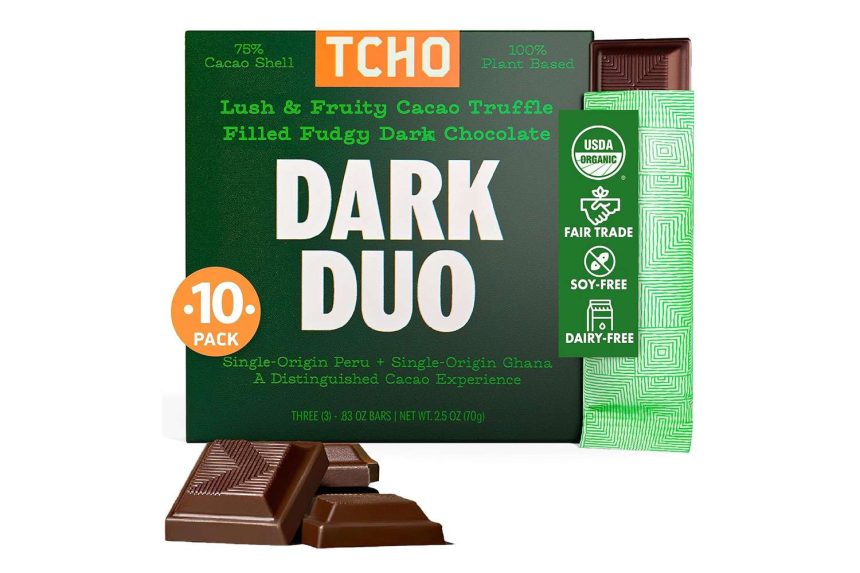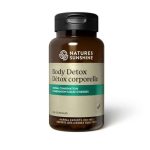I might be a registered dietitian, but that doesn’t mean I abstain from sweet treats. I almost always appreciate some chocolate—in cake form, gently folded into a cookie or simply a plain bar of chocolate.
I don’t turn down some of those mass-produced American favorites (I’m looking at you Reese’s cups…), but my preference is a couple of squares of melt-in-your-mouth dark chocolate. Remember, dark chocolate has been shown to have numerous health benefits: It’s chock-full of antioxidants (compounds that scavenge for and mop up harmful free radicals in our bodies), eating it regularly may help lower blood pressure and potentially improve heart health.
But not all dark chocolates are made equally, and nothing ruins that first bite more than when you discover the chocolate is crumbly, dry or overly bitter.
Full disclosure: If I’m going to spend a pretty penny on a gourmet chocolate bar, I need to know it’s going to be divine. And so that was the purpose of this taste test: find a high-quality, easy-to-purchase, melt-in-your–mouth delicious bar of chocolate. I started by interviewing two chocolate experts and then used their advice to create a list of gourmet chocolate bars. None of my volunteer tasters wanted to taste all 70-plus bars that were on my initial list, so I whittled it down to 14 chocolate bars and from there six expert taste-testers and I snapped, sniffed, inspected and ate over five pounds of dark chocolate.
Below are our recommendations, starting with my favorite.
Is Dark Chocolate Healthy?
Dark chocolate boasts several health benefits: It may improve heart health and help lower diabetes risk, and it can even help reduce depression. And a brand new study found that adults who eat about five servings of dark chocolate each week lower their risk of developing diabetes. Dark chocolate tends to pack a healthy boost of fiber, too. But not all chocolate bars are created equally, and some chocolates contain ingredients that are not so healthy. To reap the benefits of dark chocolate, look at the cacao percentage (higher usually equals better for you) and be mindful of added ingredients, including excess added sugar, which is used to mitigate the bitter taste in dark chocolate bars.
Origin: Ghana, Africa and Peru, South America | Cacao Percentage: 75% | Vegan? Yes
What we like: The ganache-like texture makes this bar almost irresistible.
What to know: You probably won’t find this bar in person in mainstream grocery stores. Look instead at co-ops or online.
Pronounced “cho,” this California-based chocolatier has been sourcing and crafting fine chocolates for nearly 15 years.
Founded by Timothy Childs of NASA and chocolate veteran Karl Bittong, the company works closely with cacao farmers to ensure sourcing is fair and the product exemplary. Bars are certified organic and fair trade.
We tasted the Dark Duo, which is 75% dark chocolate from Ghana with a fudgy dark chocolate cacao filling from Peru—both of which are single-origin. (“Single-origin” means the beans came from one location and sometimes one farm.) The bar is also soy- and dairy-free, non-GMO and certified kosher.
When we tasted this bar, we loved its flawlessly glossy and silky appearance, as well as its rich hickory hue with hints of auburn undertones. The bar snapped easily, revealing an almost fudge-like center.
In terms of taste, the Dark Duo bar was earthy and herbaceous initially and then, as it melted, flavors of red currant and dried cranberry emerged. The flavor lingered beautifully. As for texture, it was exactly as you’d hope: smooth and ganache-like.
Nutrition Info for TCHO Dark Duo Chocolate, per 23 g serving:
120 calories, 10 g total fat, 7 g saturated fat, 0 mg cholesterol, 0 mg sodium, 11 g carbohydrates, 2 g fiber, 6 g total sugar (6 g added sugar), 2 g protein
Origin: Ghana, Africa | Cacao Percentage: 85% | Vegan? Yes
What we like: It’s one of two bars on this list with the lowest amount of added sugars.
What to know: If you don’t care for bitter flavors, this bar probably isn’t for you.
Divine Chocolate started as a co-op of cocoa farmers in Ghana. They set up their own fair trade cocoa farm and their proceeds went to their community and social programs. Today, the company is based in the U.K., and the focus is still fair wages for cocoa farmers. It’s also committed to tackling climate change.
This dark chocolate bar starts off with a classic rich flavor and gives way to a smooth texture that coats the tongue. It tastes mildly fruity with some bitter notes that some may find intense, but that’s expected for a bar with 85% cocoa content. Some tasters noted a flavor reminiscent of toasted marshmallows. Overall, the bar finished clean and smooth—part of which might be attributed to the fact that Divine uses 100% pure cocoa butter instead of palm oil or soy as an additive.
Nutrition Info for Divine 85% Dark Chocolate Bar, per 28 g serving:
180 calories, 14 g total fat, 9 g saturated fat, 0 mg cholesterol, 0 mg sodium, 10 g carbohydrates, 4 g fiber, 4 g total sugar (4 g added sugar), 3 g protein
Origin: Dos Rios, Dominican Republic, North America | Cacao Percentage: 70% | Vegan? Yes
What we like: Amano thoughtfully sources rare cocoa beans from small-batch farmers.
What to know: This bar has the most added sugars per serving on our list.
A family-run business that follows traditional chocolate-making practices, this particular bar features cocoa beans from the Dominican Republic.
Yes, this bar’s price makes it a bit of a splurge, but its flavor and texture will leave your tastebuds feeling like they splurged, too. More so than the other bars on this list, the Amano chocolate bar had a slow, even melt that let its layered flavors slowly emerge. At first, we noticed a pronounced raisin note and a rich sweetness. There wasn’t much tartness or brightness, but we did pick up a slight fruity sourness. Then, as the bar melted, we noticed a juicy, almost milky mouthfeel and a subtle bitterness. Some tasters noticed a faint trace of licorice in the background.
Vegan, gluten-free and non-GMO, this chocolate bar’s main drawback is its higher sugar content.
Nutrition Info for Amano Artisan Chocolate Dos Rios Dark Chocolate Bar, per 40 g serving:
202 calories, 17 g total fat, 10 g saturated fat, 0 mg cholesterol, 6 mg sodium, 19 g carbohydrates, 4 g fiber, 12 g total sugar (12 g added sugar), 3 g protein
Origin: Peru, South America | Cacao Percentage: 85% | Vegan? Yes
What we like: This bar is made in a dedicated allergen-free facility and has only 4 g of sugar per serving.
What to know: You’ll probably have to buy this online as Pascha’s chocolate bars are not readily available in mainstream grocery stores.
If you’re looking for a pure chocolate bar, Pascha is it! Its bars are certified organic, plant-based, keto-friendly, non-GMO, kosher and gluten-free. Its cocoa beans are carefully harvested and delivered to a specialized factory that is entirely free of the eight major allergens. In addition, Pascha holds Rainforest Alliance certification, underscoring its commitment to ethical, sustainable practices.
As for how the bar tastes, we first noticed a burst of spice that lingers on the tongue. Then a burnt caramel flavor emerged with some bitterness. The bar melted quickly, becoming very smooth and almost milky in texture. As it continues to melt, hints of nuttiness come through. It all finishes off on a sweet note.
Overall, if you think something that’s “allergen-free” is going to fall short on taste, ignore that instinct here. Pascha Chocolate produces artisan chocolate free of additives, fillers and common allergens that is creamy and downright delicious.
Nutrition Info for Pascha 85% Cacao Organic Vegan Dark Chocolate Bar, per 27 g serving:
160 calories, 12 g total fat, 8 g saturated fat, 0 mg cholesterol, 0 mg sodium, 10 g carbohydrates, 3 g fiber, 4 g total sugar (4 g added sugar), 3 g protein
Origin: Democratic Republic of Congo, Africa | Cacao Percentage: 85% | Vegan? Yes
What we like: At just $5, this chocolate bar is priced nicely for its robust flavor. Plus, Theo is easy to find in person at major retailers.
What to know: Some of our testers noticed a taste of bitterness on the back end.
This bar is a great value for two reasons: its price at just $5 per bar and also the fact that it’s regularly available at major retailers, such as Publix, Walmart, etc. We love the fact that you can easily find this bar in person and don’t have to rely on ordering online.
As for its flavor, we initially tasted a pronounced black tea note that quickly warms and mellows, revealing a sweeter side. The bar coated the mouth well and also had pleasant notes of almond, peanut butter and toasted sesame. The finish revealed some tannic notes that some found a little too bitter.
Still, while the sharp nuances may not be desirable for some, this bar deserved a spot on our list for its blend of flavors, accessibility and purchase price.
Nutrition Info for Theo 85% Dark Chocolate Bar, per 28 g serving:
180 calories, 13 g total fat, 7 g saturated fat, 0 mg cholesterol, 0 mg sodium, 11 g carbohydrates, 4 g fiber, 4 g total sugar (4 g added sugar), 3 g protein
The Bottom Line: The Best Dark Chocolate Bars
When it comes to craft dark chocolate bars, the TCHO Dark Duo (view at Amazon) is our favorite bar in the 70% to 80% cacao range. If you’re looking for something a little darker, the Divine Dark Chocolate Bar (view at Amazon) is what we recommend. Both offer smooth finishes and distinct flavors and their company missions are applaudable.
Choosing a Dark Chocolate Bar
Check the Ingredients
Cacao can often be a bit bitter, so many conventional chocolate manufacturers add extra sugar as well as emulsifiers and additives to add texture and depth and extend shelf life. Ingredients such as cocoa butter, however, can be a more natural way to achieve the desired texture and integrity of a chocolate bar.
When choosing a gourmet bar, chocolate expert Kathy D’Agostino of Chocolatá suggests avoiding fillers and unnecessary flavorings. “The fewer the ingredients, the better,” says D’Agostino. “Some people put wax or paraffin in [the chocolate] to replace the cacao butter. You want cacao, cacao butter and sugar.”
Finally, if you suffer from a particular allergy, check the ingredient list for potential allergens and the packaging for allergen certifications, such as certified gluten free. Or, if you follow a vegan diet, make sure all of the ingredients are vegan or that the bar is certified vegan.
Note the Percentage of Cacao or Cocoa
When it comes to chocolate, you’ll also want to look at the cacao and cocoa percentages.
The basic rule of thumb is this: The darker the chocolate, the higher the percentage of cacao (or cocoa). And the higher the percentage, the greater the health benefits. Aim to find a bar with at least 70% cacao or cocoa—that’s a good starting place to get those health perks.
Is It Ethically Sourced?
Historically, the chocolate industry has been known to have some unethical practices, such as child labor, unfair farmer wages and even deforestation. However, thanks to independent verification certifications, it’s easier to identify the more ethical chocolate makers. If transparent sourcing and ethical practices are important to you, seek out chocolate bars with labels like USDA Organic and Fair Trade, as each of those certifications has stringent requirements for a product to bear their label.
EatingWell
Our Dark Chocolate Tests
To find the best dark chocolate available, I first interviewed two chocolate experts to better understand what is considered a high-quality “craft” or “gourmet” chocolate bar. Using the information from the interviews, I curated a researched list of craft dark chocolate bars, taking into account the sourcing and manufacturing practices of each chocolate producer, product availability and price.
Then to make our final selection, I enlisted a team of taste testers to sample 14 high-end craft dark chocolate bars. For each bar, we observed its appearance, including the glossiness, and looked for any signs of blooming or bubbling. We broke each chocolate bar in half to observe how “snappy” it was—an indication of the quality of production. (Did it give us a clean break? Did it crumble into pieces afterward?) If it didn’t snap well and it crumbled, then it suggested the chocolate wasn’t tempered properly.
We tasted a piece of each chocolate bar to observe the texture (i.e. gritty or smooth), mouthfeel and flavor.
We Also Considered
Equal Exchange Very Dark Chocolate Bars (12-pack for $70 at Amazon) We liked that this bar’s ingredients are sourced organically and in tandem with small co-op farmers. This bar is also vegan, certified kosher, free of soy and gluten and certified organic. But it didn’t make our list of top picks because we found it to be a bit more bitter than others we tasted.
K’UL Chocolate Bar—Pure Dark Chocolate, 80% ($7 per bar at K’UL): We found this bar mellow and fruity in flavor with a bit of a tannic and bitter finish. Overall, though, we did not find this bar exceptional, particularly for its short finish.
Beyond Good Organic 70% Madagascar Dark Chocolate Bar ($4 per bar at Amazon): When we tasted this bar, we observed notes of umami soy flavors, herbs and black tea, but the taste ended with a short, unremarkable finish. We also noticed some slight bubbling and blooming on this bar, which can indicate a lesser quality.
Taza Chocolate Bars—Deliciously Dark, 70% (10-pack for $54 at Amazon): This bar was the only unrefined, stone-ground chocolate we tested, and the texture and mouthfeel were rough and gritty. While we appreciate the way this bar is made, we found the texture to be a little too distracting.
EatingWell
Common Questions
Is there caffeine in dark chocolate?
Yes! Generally speaking, the darker the chocolate, the more caffeine it contains. For example, a 1-ounce piece of chocolate as dark as the bars on this list (70% to 85%) has around 23 mg caffeine. A similar-sized piece of milk chocolate has about half that amount of caffeine.
Is dark chocolate vegan?
Dark chocolate is naturally vegan so, yes, many dark chocolate bars are vegan. But some chocolate-makers may add fillers, such as dairy, to change the structure and texture of bars. Check the ingredient list and also the fine print to make sure the manufacturer does not use dairy or animal products in its bars.
In most instances, milk chocolate and white chocolate are not typically vegan unless the chocolatier (like Pascha) specifically creates a vegan version.
Does dark chocolate have heavy metals in it?
In 2023, Consumer Reports tested 48 different cacao-containing products (from brownie mixes to hot cocoa to chocolate bars) and found increased levels of heavy metals, such as cadmium and lead, in over one-third of the products tested. High levels of metals can harm your immune system, raise your blood pressure, and cause other negative health effects. In young children and pregnant women, the effects can be worse.
Experts say that dark chocolate is more likely to contain higher levels of heavy metals because dark chocolate contains more cacao beans, cacao beans contain more cocoa solids and metals tend to accumulate in those solids. Does that mean dark chocolate is off-limits? No. Experts recommend enjoying it in moderation and if you’re pregnant or feeding children, be more judicious in how much is consumed.
What’s the difference between craft chocolate and conventional chocolate—and how can you find a high-quality dark chocolate bar?
There isn’t an official definition for “craft” or “gourmet” or “conventional” chocolate, unfortunately, so the answer isn’t black and white. But I asked the two chocolate experts I interviewed how they would define it and what we, as consumers, should look for to differentiate between the various chocolate bars on store shelves.
“Industrial chocolate is mass-produced and is uniform in taste, while craft chocolate is more nuanced,” Sophia Rea, owner of Projet Chocolat and Atlas Obscura chocolate course teacher. “This is because craft chocolate makers focus on the flavor of the beans they are working with, using transparency with cacao bean sourcing and making chocolate in smaller batches.”
To distinguish between conventional and craft chocolate, D’Agostino recommends looking to see if the chocolate maker lists the region the cacao was sourced from. “If the region is listed, then you know the company is paying close attention to sourcing, and that’s a sign of higher-quality chocolate.” Price can also be an indicator; D’Agostino says it “costs a lot more to make fine chocolate, as cacao butter is really expensive.”
Lastly, D’Agostino suggests checking to see if the bar was tempered properly. Tempering refers to the process of heating and cooling chocolate, and when done correctly, it makes the chocolate “glossy, shiny and snappable.” A chocolate bar should snap cleanly and easily; if it crumbles, then the chocolate bar may have not been tempered properly.
Our Trusted Expertise
Brierley Horton, M.S., RD, (pictured below tasting chocolate) is a senior editor at EatingWell. She “forced” herself to smell and nibble on countless pieces of dark chocolate to bring you this list of the best dark chocolate bars. She also has 15 years of experience reporting, writing, and editing nutrition and health content.
For this article, she also consulted two chocolate experts: Kathy D’Agostino of Chocolatá and Sophia Rea of Projet Chocolat for insights on how to identify the highest-quality dark chocolates and what distinguishes craft chocolate from conventionally made chocolate.
EatingWell


:max_bytes(150000):strip_icc()/Divine-Chocolate-85-Dark-Chocolate-Bar-08bb0ffdec9445819c6815c649cd5deb.jpg)
:max_bytes(150000):strip_icc()/Amano-Artison-Chocolate-Dos-Rios-70-Dark-Chocolate-Bar-e4bf1f498c7d40f2bea9e4b634e89cc5.jpg)
:max_bytes(150000):strip_icc()/Pascha-Organic-Dark-Chocolate-Bars-85-Cacao-0865db1f0c364257bd884bf8c9e5359e.jpg)
:max_bytes(150000):strip_icc()/theo-chocolate-pure-organic-dark-chocolate-bar-85-cacao-6-pack--vegan-fair-trade--6887f240184e455f9a1b1964f4b3d7b0.jpg)





